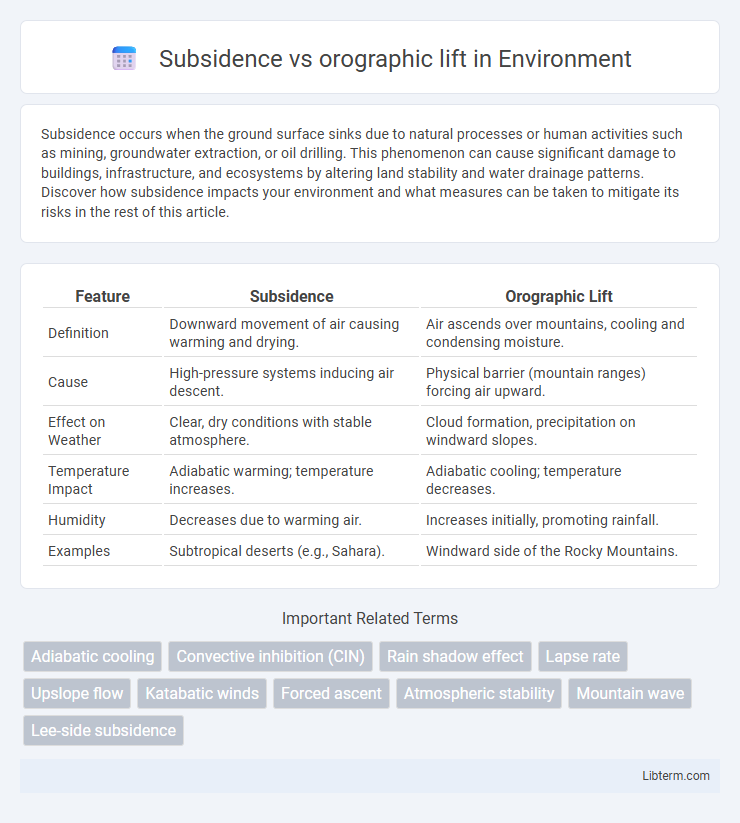Subsidence occurs when the ground surface sinks due to natural processes or human activities such as mining, groundwater extraction, or oil drilling. This phenomenon can cause significant damage to buildings, infrastructure, and ecosystems by altering land stability and water drainage patterns. Discover how subsidence impacts your environment and what measures can be taken to mitigate its risks in the rest of this article.
Table of Comparison
| Feature | Subsidence | Orographic Lift |
|---|---|---|
| Definition | Downward movement of air causing warming and drying. | Air ascends over mountains, cooling and condensing moisture. |
| Cause | High-pressure systems inducing air descent. | Physical barrier (mountain ranges) forcing air upward. |
| Effect on Weather | Clear, dry conditions with stable atmosphere. | Cloud formation, precipitation on windward slopes. |
| Temperature Impact | Adiabatic warming; temperature increases. | Adiabatic cooling; temperature decreases. |
| Humidity | Decreases due to warming air. | Increases initially, promoting rainfall. |
| Examples | Subtropical deserts (e.g., Sahara). | Windward side of the Rocky Mountains. |
Introduction to Atmospheric Vertical Motions
Subsidence and orographic lift are key atmospheric vertical motions influencing weather patterns and climate. Subsidence involves the downward movement of air, leading to warming and drying conditions often associated with high-pressure systems. Orographic lift occurs when air masses ascend over mountainous terrain, cooling adiabatically, enhancing cloud formation and precipitation on windward slopes.
Defining Subsidence: Causes and Characteristics
Subsidence refers to the downward movement of air in the atmosphere, typically caused by high-pressure systems that force air to descend. This process results in warming and drying of the air, suppressing cloud formation and precipitation. In contrast, orographic lift occurs when moist air is forced upward over mountainous terrain, cooling and condensing to produce clouds and precipitation.
Understanding Orographic Lift: Key Mechanisms
Orographic lift occurs when moist air masses ascend along mountain slopes, cooling adiabatically and causing condensation that leads to cloud formation and precipitation on the windward side. This key mechanism contrasts with subsidence, where descending air warms adiabatically, inhibiting cloud formation and creating dry conditions often found in rain shadow regions. Understanding orographic lift is crucial for predicting local climate patterns, rainfall distribution, and ecosystem diversity in mountainous areas.
Differences between Subsidence and Orographic Lift
Subsidence occurs when air descends, causing compression and warming, which typically leads to dry and stable atmospheric conditions. Orographic lift involves air being forced upward over a mountain or other terrain, resulting in cooling, condensation, and often precipitation on the windward side. The key difference lies in the vertical air movement: subsidence is downward, promoting dryness, whereas orographic lift is upward, enhancing cloud formation and rainfall.
Impact on Weather Patterns and Precipitation
Subsidence causes air to descend, warming and drying as it compresses, which suppresses cloud formation and reduces precipitation in affected regions. Orographic lift forces moist air to rise over mountains, cooling and condensing it to form clouds and heavy rainfall on the windward side, creating rain shadows with dry conditions on the leeward side. These contrasting processes result in distinct microclimates, where subsidence promotes arid environments and orographic lift enhances localized precipitation and complex weather patterns.
Subsidence in High-Pressure Systems
Subsidence in high-pressure systems occurs when descending air compresses and warms, inhibiting cloud formation and resulting in clear skies and dry conditions. This downward movement contrasts sharply with orographic lift, where air rises over elevated terrain, cools, and often causes precipitation. High-pressure subsidence plays a critical role in stabilizing the atmosphere and maintaining arid climates in regions such as deserts and subtropical zones.
Orographic Lift and Mountain-Driven Weather
Orographic lift occurs when moist air masses are forced to ascend over mountain ranges, causing cooling and condensation that results in enhanced precipitation on the windward slopes. This mountain-driven weather phenomenon significantly influences local climates by creating distinct rain shadows on the leeward side, where descending air warms and dries. Understanding orographic lift is crucial for predicting precipitation distribution, watershed management, and assessing ecological impacts in mountainous regions.
Environmental Implications of Subsidence
Subsidence, the gradual sinking of land due to natural or human activities such as groundwater extraction or mining, leads to altered drainage patterns and increased flood risk, impacting ecosystems and infrastructure. Orographic lift, which causes precipitation as moist air ascends over mountains, influences local climate and biodiversity but does not contribute to land degradation like subsidence. The environmental implications of subsidence include habitat loss, soil compaction, reduced agricultural productivity, and increased vulnerability to sea-level rise in coastal regions.
Role of Orographic Lift in Climate and Ecology
Orographic lift plays a crucial role in shaping local climates by forcing moist air to ascend mountainous terrains, resulting in enhanced precipitation on the windward slopes and creating lush, biodiverse ecosystems. This upward air movement contrasts with subsidence, where descending air leads to drier conditions and arid landscapes, often forming rain shadows on leeward mountain sides. The climate and ecological patterns driven by orographic lift support rich forests and unique habitats, influencing water resources and agricultural practices in mountainous regions worldwide.
Summary: Comparing Subsidence and Orographic Lift
Subsidence involves the downward movement of air, leading to warming and drying, which suppresses cloud formation and precipitation. Orographic lift occurs when air rises over mountains, cooling and condensing to produce clouds and heavy rainfall, especially on windward slopes. Comparing the two, subsidence creates dry, stable conditions while orographic lift promotes moist, unstable weather and significant precipitation.
Subsidence Infographic

 libterm.com
libterm.com